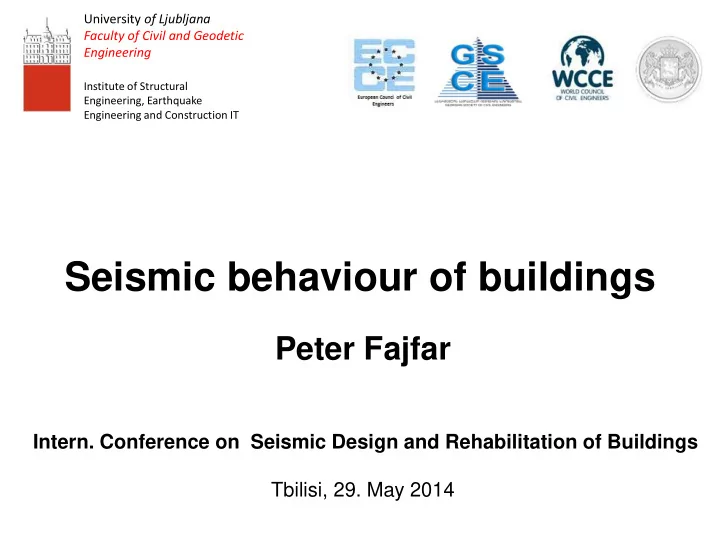

University of Ljubljana Faculty of Civil and Geodetic Engineering Institute of Structural Engineering, Earthquake Engineering and Construction IT Seismic behaviour of buildings Peter Fajfar Intern. Conference on Seismic Design and Rehabilitation of Buildings Tbilisi, 29. May 2014
Damage versus year of construction Minor damage Moderate damage KOBE 1995 Major damage Collapse % of before 1972 1972 to 1981 After 1981 buildings
Recent earthquakes L‘Aquila, Italy, 2009 Haiti, 2010 Chile, 2010 Christchurch, New Zealand 2010, 2011 Tohoku, Japan, 2011 Emilia, Italy 2012
Lessons learned/confirmed • Present codes and guidelines generally provide adequate protection against collapse • Major problem are older structures • Failure of some new structures • Often large non-structural damage • Ground motion can be much stronger than expected
L‘Aquila, Italy, 2009 • M=6.3 • 287 deaths • About 40.000 homeless • About 20 billion Euro damage • Historical center of L‘ Aquila destroyed
Italy L’Aquila 2009
Observations • Moderate magnitude, short duration, large intensity • Heavy damage and complete collapses of many old masonry buildings • Horizontal ties prevented collapses • Heavy damage and complete collapses of some reinforced concrete buildings
Stiftung für Baudynamik und Erdbebeningenieurwesen, Schweiz (E.Rosales)
Stiftung für Baudynamik und Erdbebeningenieurwesen, Schweiz (E.Rosales)
Haiti 2010 • M=7.0 • About 300.000 deaths • About 300.000 wounded • About 1,300.000 homeless • Loss amounts to 120 % of GDP • The most destructive earthquake that any country has experienced when measured in terms of the number of people killed relative to its population
Haiti 2010
Haiti 2010 • Inadequate Construction Practice – Powerty – Lack of professionals in construction industry – No seismic code
Chile 2010 • M=8.8 • About 580 deaths • About 800.000 homeless • About 40 billion Euro damage • Good behaviour of engineered structures • Some problems with code
CHILE 2010
Chile 2010
Observations • Extreme magnitude, long duration, moderate intensity • Majority of engineered structures behaved well • Some buildings, including very new ones, heavily damaged • New: Systematic local brittle failures of slender walls with large compression in new buildings, especially in first basement. Inadequate confinement for high axial stress.
Santiago
Typical high-rise buildings - Chile
Behaviour of buildings
Characteristics of building structures "Edificios Chilenos de Hormigón Armado," ICH, 2002
Problem The area of walls as a fraction of the total floor area has remained about constant, but the number of stories has increased significantly, resulting in higher axial stresses in the walls.
Additional problems Vertical irregularities, mostly vertical setbacks (narrowing of walls near base –”flag wall” configuration) Long duration of earthquake – a large number of loading cycles – and strong aftershocks
First basement
Accelerogram Santiago L’Aquila Soto, Boroschek
Alto Rio, Conception During the earthquake 87 persons in building • 15 stories, RC, Appartments - 8 deaths - 79 survivors • 2 underground stories 52 came from building themselves • built in 2008 27 rescued Fabian Rojas, USC
Alto Rio Fabian Rojas, USC
Christchurch 2010, 2011 • 4.9.2010: M=7.1, a gmax = 1.26 g • 22.2.2011: M=6.3, a gmax = 2.20 g, 185 deaths • 13.6.2011: M=6.3 • 23.12.2011: M=5.8 • Much stronger ground motion than expected • Heavy damage (150000 homes damaged) • Liquefaction • More than 10000 aftershocks
Christchurch 2010
Christchurch 2011
Japan 2011 • M=9.0 + tsunami • About 25.000 deaths (mostly from tsunami) • About 300.000 homeless • About 200 billion Euro damage • PGA = 3g • Good behaviour of engineered structures • Severe underestimation of tsunami • Nuclear disaster • Early warning
Tohoku Japan 2011
Accelerograms
Maximum accelerations
Japan 2011 Tohoku University, Sendai
Emilia, Italy, 2012 • M=6.0 (20. May) • M=5.8 (29. May) • 26 deaths • Collapse of prefabricated RC industrial buildings • Underestimation of ground motion / inadequate code
Emilia 2012
Emilia Italy 2012
Observations • Moderate magnitude, moderate intensity • Heavy damage and collapses of masonry buildings, including cultural heritage buildings • Heavy damage and collapses of numerous prefabricated RC industrial buildings, including relatively new ones – The region was until 2003 not defined as „seismic“, in the period 2003-2006 the seismic design loads were quite low
MONTENEGRO 1979
Lessons learned/confirmed • Present codes and guidelines generally provide adequate protection against collapse • Major problem are older structures • Failure of some new structures • Often large non-structural damage • Ground motion can be much stronger than expected
Thank you დიდი მადლობა
Recommend
More recommend